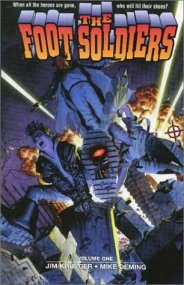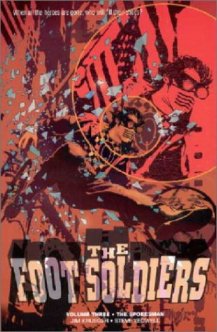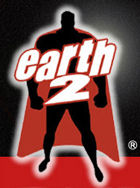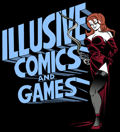| The
Foot Soldiers
 |
Originality
is not a virtue that lends itself well to the superhero genre
nowadays, and it's not the fault of the writers or the artists.
Put simply, most of it's been done before. Every kind of superpower
imaginable has been imagined, from "cosmic awareness"
to "super fecal matter" (believe it or not, both
Erik Larsen and Mark Millar have used the latter). Stan Lee
used to comment on how hard it was to come up with superhero
and villain names during his golden age of character creation
at Marvel Comics, and that was decades ago. It has become
increasingly difficult to mix Character A with Superpower
B, shake well, and come up with a superhero that doesn't feel
like a derivative second cousin to an established do-gooder.
Dark Vigilante Avenger who only uses his wits and well honed
combat skill to battle evil is a "Batman" and anyone
that grows anything out of their hands had better be Wolverine's
long lost offspring, or the character will be panned as a
knock-off (I'm looking at you Ripclaw).
Essentially,
this is one of the problems with the genre of superheroes:
we build up these icons out of the heroes, making them representative
of their powers more than their individual character. All
new characters are then seen as "not as good as the original"
and are summarily ignored by the cash-paying public. This
shoots the creator who wants to tell his own superhero stories
directly in the foot when trying to get his book read and
probably keeps more than one fanperson from reading what could
be interesting material.
Jim Krueger
manages to write a superhero story that is refreshingly original
when placed against its peers, keeping clear of any obvious
ties to any one icon of superheroism.
The story
takes place in an undetermined future where the Bio Technic
Law (B.T.L. or Beetles) control the population through the
use of their insectoid-robotic mecha. Healthy children are
taken from their mothers as infants while the sickly are left
to live in the ghettos of the future, surviving on rations
doled out by their overseers. Reading and writing are archaic
practices and one can be executed for stealing a loaf of bread.
About
to be executed for theft, the boy called Story is saved by
an act of mercy and led to his destiny. When Story, Johnny,
and the blind beggar Rags are lead to a hidden cemetery by
an old man with a glowing walking stick, they discover the
Graveyard of Forgotten Heroes! And what does one do when one
finds a Graveyard chalk full of super corpses? That's right,
go grave robbing. Grab your shovels!
It's at
this point that Krueger injects some oddly original concepts.
Story picks a pair of stilt boots from his grave-o-delight
and becomes The Second Story Kid. As lame as the idea sounds,
and as easy as it is to make a Stilt-Man joke right now, Krueger
uses Story's unique power both for the story purposes and
metaphorically. Story's power takes him above his friends
and lets him look down on, or "gain perspective"
on what the Foot Soldiers are doing.
This leads
to Story asking some of the harder, but ultimately logical
questions as the plot goes on: How did the Old Man know about
the graveyard? Why would heroes, known for wearing masks and
using secret identities have a graveyard full of stone idols
to their own greatness? Are the Foot Soldiers actually accomplishing
anything?
Krueger
uses Story as a narrator at the end of each chapter, providing
a small page of text that outlines Story's thoughts and inquiries
about what the Foot Soldiers accomplish or fail to accomplish.
He's the philosopher of the group, the thinker, and Krueger
keeps the reader off balance when he raises questions about
the plot that you forget to ask while reading, making you
re-read to make sure you covered all the salient points.
The other
Foot Soldiers, Johnny Stomp and Rags, both obtain powers from
the graveyard. Johnny snags a pair of ridiculously large boots
from a skeleton in a jumpsuit, which enable him to well, stomp
things really, really hard and Rags finds some rags (coincidence,
Krueger? I think not) that heal all ailments.
In Rags,
Krueger creates a Christ-like figure as the boy is willing
to give up his "power" to heal those around him,
even willing to lose his regained sight so that someone might
be free of pain or disease. In the first volume, Michael Avon
Oeming creates a visual nod to Krueger's characterization
when showing Rags propped up against a manhole cover, alluding
to a halo around his head. Rags is a moral compass for the
rest of the Foot Soldiers to follow, and Krueger often uses
this to show that Story and even the overconfident Johnny
both strive to be as "good" as Rags, to become heroes
in more than one way.
And that
may be Krueger's point in writing The Foot Soldiers:
to show the many ways people can be heroes. Let's admit it;
the Foot Soldiers' powers are somewhat lame and even ineffective
at times. Their powers do not define them so much as complement
their personalities. Story is the objective questioner so
his power gives him an objective view of the world he inhabits.
Johnny's stomp boots are an extension of his anger and his
inability to look before he leaps…onto the Beetle Mech
he's crushing. And Rags' passive ability to heal can only
be used to help people, which is what he does anyway. Krueger
made the characters before he made the powers, the powers
only being there to fill a plot related need.
The first
volume sets up the story for The Foot Soldiers, while the
second introduces the real threat behind the scenes of Krueger's
plot, which ties right back to the first few pages of the
first volume. Gotta love cyclic plot points. The first volume
is illustrated by Mike (Powers, Hammer of the Gods) Oeming,
with the second done by Phil (Green Arrow, The Wretch) Hester.
I'm more
fond of Oeming's take on the characters than Hester's, but
that doesn't mean they're not both spectacular. Foot Soldiers
was originally published by Dark Horse Comics back in 1996,
and was before Oeming managed to perfect his art style into
the one he currently employs on Powers, drawing such
things as superheroics and monkey coitus.
What's
interesting is that unlike some early work of artists with
a recognizable artistic flare; Oeming's art doesn't look sketchy
or unpolished. It's more of a combination of his usual simplistic
cartoon style with a more realistic tone. There's greater
detail in his character work and backgrounds and better attention
paid to facial expression and emotion than in Hester's work.
But Hester handles the action sequences very well, as anyone
who reads Green Arrow can attest to. Hester draws some
beautiful splash pages in the second volume, as well as illustrating
Krueger's poem in the back called, "The Greatest Hero
Who Ever Died."
Each volume
collects four issues of each series, as well as several back-up
stories illustrated by other artists. There are also some
blurbs from other comic book writers and artists, espousing
their love of The Foot Soldiers and its popularity
(apparently, it was mightily popular back in 1996); everyone
from Alan Moore to the late Mark Gruenwald had nice things
to say. In the back of volume one, Krueger outlines the creation
process that led to the book, as well as his many influences
from the comic book, cinema, and book worlds. Volume two boasts
script excerpts from the third volume (which I haven't been
able to get my hands on yet, which features art by Invisibles
alum Steve Yeowell), as well as the illustrated poem mentioned
above.
I wish
I'd been able to review all three volumes at once, because
Krueger seems to have written a very intricate story that
deserves full consideration. Luckily, these two volumes are
just as stronger on their own as together, and I'm thankful
AiT/PlanetLAR decided to collect the disparate issues of this
series in three tight volumes. They're well worth the cash
at only $14.95 a piece, and a welcome addition to anyone's
bookshelf. Go and buy, because the Great Month of Capitalism
has descended upon us, and no one shall escape its wrath.
The
Foot Soldiers vol. 1
Foot
Soldiers, Vol. 3: The Spokesman
|







